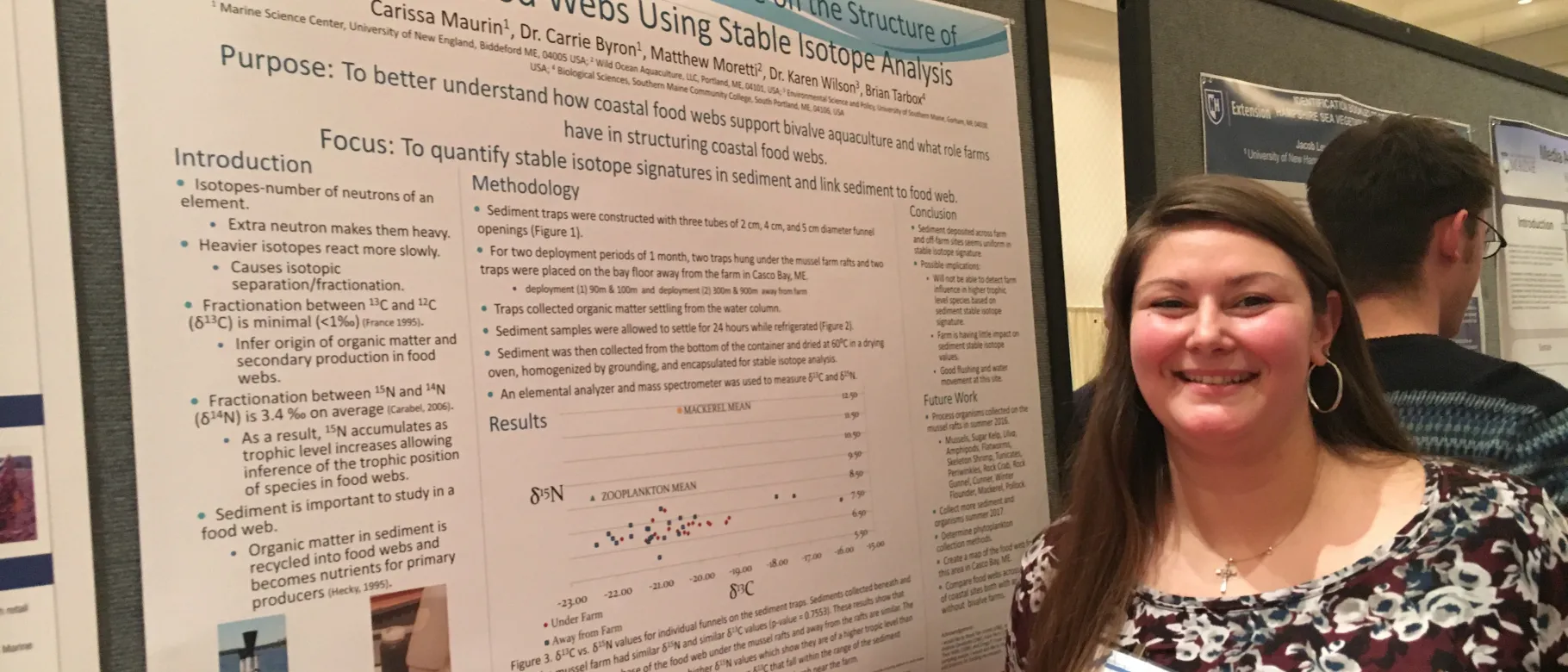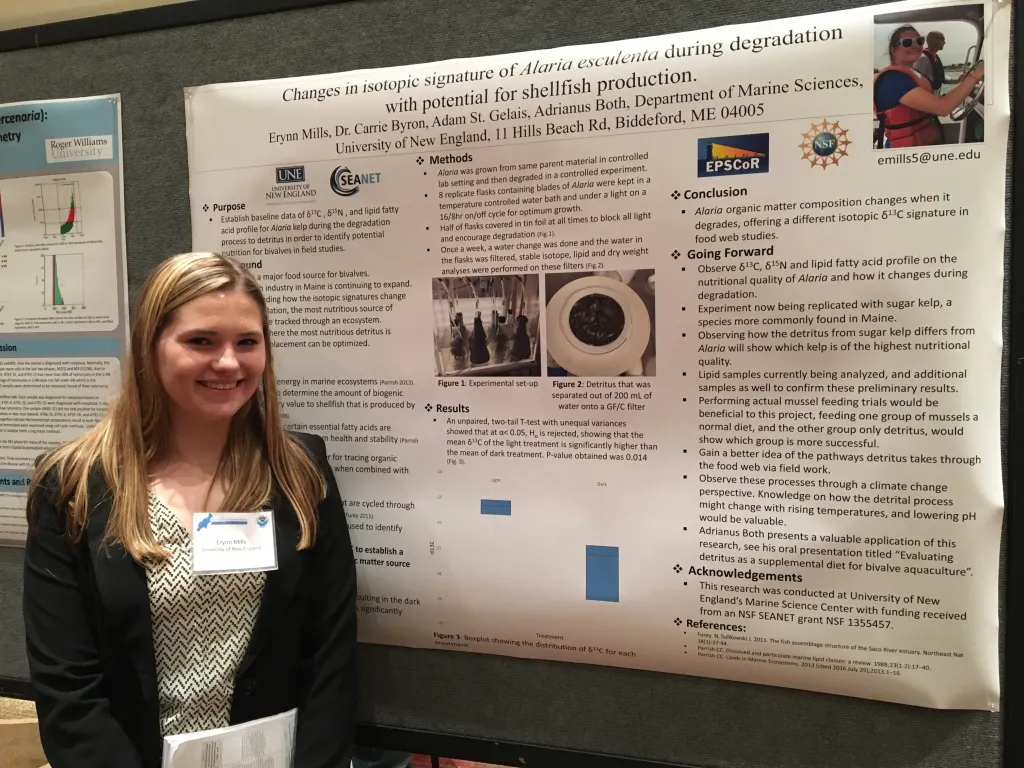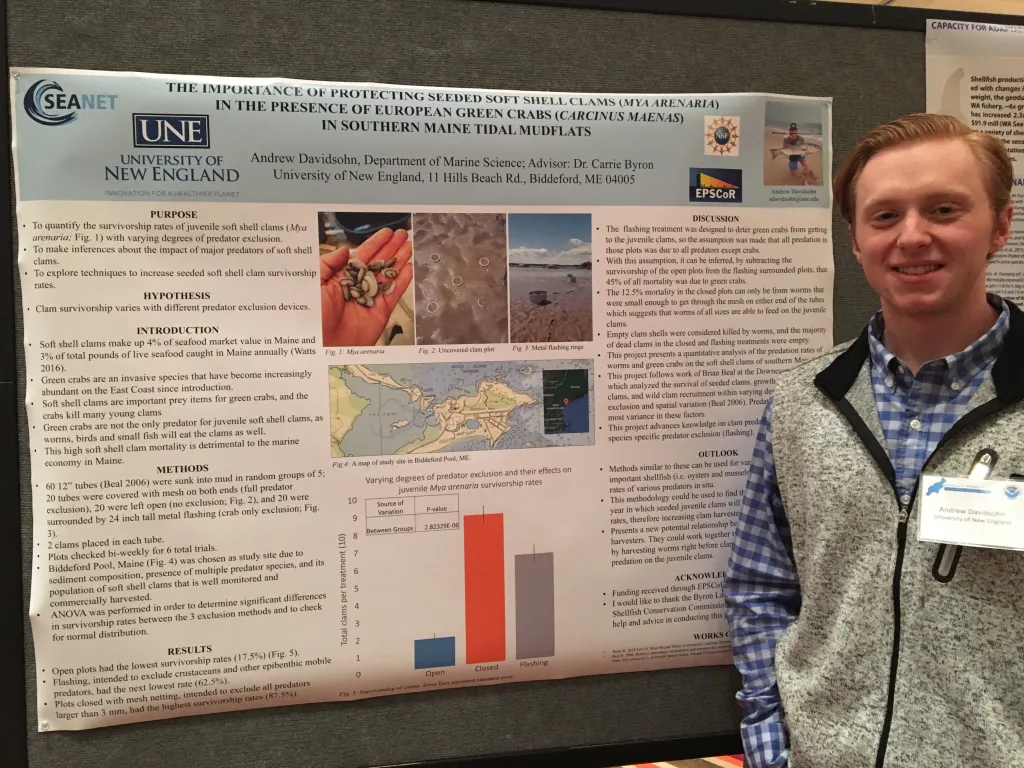UNE Marine Science well represented at 2017 Northeast Aquaculture Conference & Exposition

Several students, faculty and staff members from the University of New England Department of Marine Sciences and Center for Excellence in the Marine Sciences presented their research at the 2017 Northeast Aquaculture Conference & Exposition and 37th Milford Aquaculture.
Assistant Professor Carrie Byron, Ph.D., and Eric Chapman, a postdoctoral fellow in the Center for Excellence in Marine Sciences, presented a framework for linking ecological and economic models to evaluate the natural resource potential of bivalve shellfish in coastal environments. The research, titled, “A coastal ecosystem service valuation approach for sustainable resource management” was presented as a potential management tool for resource managers in coastal areas.
Byron, along with Chair of the UNE Department of Marine Sciences, Director of the Center for Excellence in Marine Sciences and Henry L. & Grace Doherty Professor of Marine Sciences Barry Costa-Pierce, Ph.D., and Ph.D. student Adrianus Both presented, “Evaluating detritus as a supplemental diet for bivalve aquaculture.” The research aims to determine the role detritus plays in the environment as well as the diets of bivalves to allow for better site selection in bivalve aquaculture.
Ph.D. student Gretchen Grebe presented “Improved siting of kelp aquaculture using N15 stable isotope analysis.” The research aims to help existing sea vegetable farmers and harvesters within the state by providing them with more insight into the relationship between the local marine environment and the characteristics of the kelp they are harvesting.
Graduate student Carissa Maurin collaborated with Byron on “Effects of shellfish aquaculture on the structure of coastal food webs using stable isotope analysis.” The goal of the research is to prove that there is little to no impact in adding an aquaculture system to an ecosystem, which would help aquaculture farms obtain permits more easily and boost the economy by allowing more aquaculture farms.
Andrew Davidsohn ’18 presented “The importance of protecting seeded soft shell clams (Mya arenaria) in the presence of European green crabs (Carcinus maenas) in Southern Maine tidal mudflats.” The research, which he conducted with Byron, demonstrated the importance of using predator exclusion to protect seeded juvenile soft shell clams from native and invasive predators, like the European green crab. The study also found a 45% mortality rate caused by crabs (assumedly green crabs), which represents a large portion of mortalities that can be avoided by simply using landscape mesh to cover seeded juvenile soft shell clams.
Katherine Perry ’18 presented “Metabolic efficiency and nutritional profiles in commercial grown bivalves to optimize farm placement,” which was co-authored by Byron. Oysters and mussels contain some of the essential fatty acids that humans need for survival, therefore making them important in human nutrition. The study enhanced the knowledge of how these organisms use and retain nutrients they gather from their ecosystems, making it possible to optimize farm placements to produce nutrient dense shellfish.
Erynn Mills ’19 presented “Changes in nutritional value of Alaria esculenta during degradation with potential for shellfish production,” which she researched with Byron, Both, and Adam St. Gelais, M.S., assistant research scientist. The study examined how the composition of kelp changes as it degrades in order to detect the ingestion and subsequent utilization of kelp detritus for shellfish growth.
St. Gelais also presented on two important topics pertaining to seaweed aquaculture: Farm siting and implications to public health and product quality, and farm system engineering. He also sat on a discussion panel of regional seaweed aquaculture scientists and phycologists. St. Gelais helped develop the UNE Macroalgae Nursery and Research Cluster in the Arthur P. Girard Marine Science Center and established a demonstration kelp farm in Saco Bay in order to conduct applied seaweed research and aid the growing seaweed industry.
To learn more about the University of New England’s Center for Excellence in Marine Sciences, visit www.une.edu/research/msc
To learn more about the University of New England’s Department of Marine Sciences visit www.une.edu/cas/marine
To apply, visit www.une.edu/admissions

